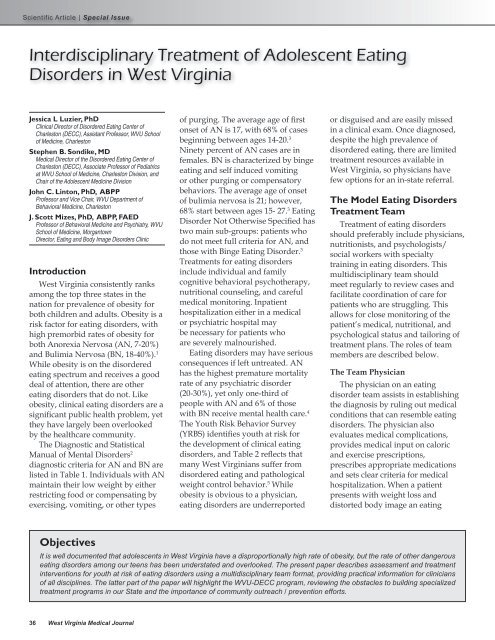Special CME Issue - West Virginia State Medical Association
Special CME Issue - West Virginia State Medical Association
Special CME Issue - West Virginia State Medical Association
Create successful ePaper yourself
Turn your PDF publications into a flip-book with our unique Google optimized e-Paper software.
Interdisciplinary Treatment of Adolescent Eating<br />
Disorders in <strong>West</strong> <strong>Virginia</strong><br />
Jessica L Luzier, PhD<br />
Clinical Director of Disordered Eating Center of<br />
Charleston (DECC), Assistant Professor, WVU School<br />
of Medicine, Charleston<br />
Stephen B. Sondike, MD<br />
<strong>Medical</strong> Director of the Disordered Eating Center of<br />
Charleston (DECC), Associate Professor of Pediatrics<br />
at WVU School of Medicine, Charleston Division, and<br />
Chair of the Adolescent Medicine Division<br />
John C. Linton, PhD, ABPP<br />
Professor and Vice Chair, WVU Department of<br />
Behavioral Medicine, Charleston<br />
J. Scott Mizes, PhD, ABPP, FAED<br />
Professor of Behavioral Medicine and Psychiatry, WVU<br />
School of Medicine, Morgantown<br />
Director, Eating and Body Image Disorders Clinic<br />
Introduction<br />
<strong>West</strong> <strong>Virginia</strong> consistently ranks<br />
among the top three states in the<br />
nation for prevalence of obesity for<br />
both children and adults. Obesity is a<br />
risk factor for eating disorders, with<br />
high premorbid rates of obesity for<br />
both Anorexia Nervosa (AN, 7-20%)<br />
and Bulimia Nervosa (BN, 18-40%). 1<br />
While obesity is on the disordered<br />
eating spectrum and receives a good<br />
deal of attention, there are other<br />
eating disorders that do not. Like<br />
obesity, clinical eating disorders are a<br />
significant public health problem, yet<br />
they have largely been overlooked<br />
by the healthcare community.<br />
The Diagnostic and Statistical<br />
Manual of Mental Disorders 2<br />
diagnostic criteria for AN and BN are<br />
listed in Table 1. Individuals with AN<br />
maintain their low weight by either<br />
restricting food or compensating by<br />
exercising, vomiting, or other types<br />
of purging. The average age of first<br />
onset of AN is 17, with 68% of cases<br />
beginning between ages 14-20. 3<br />
Ninety percent of AN cases are in<br />
females. BN is characterized by binge<br />
eating and self induced vomiting<br />
or other purging or compensatory<br />
behaviors. The average age of onset<br />
of bulimia nervosa is 21; however,<br />
68% start between ages 15- 27. 3 Eating<br />
Disorder Not Otherwise Specified has<br />
two main sub-groups: patients who<br />
do not meet full criteria for AN, and<br />
those with Binge Eating Disorder. 3<br />
Treatments for eating disorders<br />
include individual and family<br />
cognitive behavioral psychotherapy,<br />
nutritional counseling, and careful<br />
medical monitoring. Inpatient<br />
hospitalization either in a medical<br />
or psychiatric hospital may<br />
be necessary for patients who<br />
are severely malnourished.<br />
Eating disorders may have serious<br />
consequences if left untreated. AN<br />
has the highest premature mortality<br />
rate of any psychiatric disorder<br />
(20-30%), yet only one-third of<br />
people with AN and 6% of those<br />
with BN receive mental health care. 4<br />
The Youth Risk Behavior Survey<br />
(YRBS) identifies youth at risk for<br />
the development of clinical eating<br />
disorders, and Table 2 reflects that<br />
many <strong>West</strong> <strong>Virginia</strong>ns suffer from<br />
disordered eating and pathological<br />
weight control behavior. 5 While<br />
obesity is obvious to a physician,<br />
eating disorders are underreported<br />
or disguised and are easily missed<br />
in a clinical exam. Once diagnosed,<br />
despite the high prevalence of<br />
disordered eating, there are limited<br />
treatment resources available in<br />
<strong>West</strong> <strong>Virginia</strong>, so physicians have<br />
few options for an in-state referral.<br />
The Model Eating Disorders<br />
Treatment Team<br />
Treatment of eating disorders<br />
should preferably include physicians,<br />
nutritionists, and psychologists/<br />
social workers with specialty<br />
training in eating disorders. This<br />
multidisciplinary team should<br />
meet regularly to review cases and<br />
facilitate coordination of care for<br />
patients who are struggling. This<br />
allows for close monitoring of the<br />
patient’s medical, nutritional, and<br />
psychological status and tailoring of<br />
treatment plans. The roles of team<br />
members are described below.<br />
The Team Physician<br />
The physician on an eating<br />
disorder team assists in establishing<br />
the diagnosis by ruling out medical<br />
conditions that can resemble eating<br />
disorders. The physician also<br />
evaluates medical complications,<br />
provides medical input on caloric<br />
and exercise prescriptions,<br />
prescribes appropriate medications<br />
and sets clear criteria for medical<br />
hospitalization. When a patient<br />
presents with weight loss and<br />
distorted body image an eating<br />
Objectives<br />
It is well documented that adolescents in <strong>West</strong> <strong>Virginia</strong> have a disproportionally high rate of obesity, but the rate of other dangerous<br />
eating disorders among our teens has been understated and overlooked. The present paper describes assessment and treatment<br />
interventions for youth at risk of eating disorders using a multidisciplinary team format, providing practical information for clinicians<br />
of all disciplines. The latter part of the paper will highlight the WVU-DECC program, reviewing the obstacles to building specialized<br />
treatment programs in our <strong>State</strong> and the importance of community outreach / prevention efforts.<br />
36 <strong>West</strong> <strong>Virginia</strong> <strong>Medical</strong> Journal















